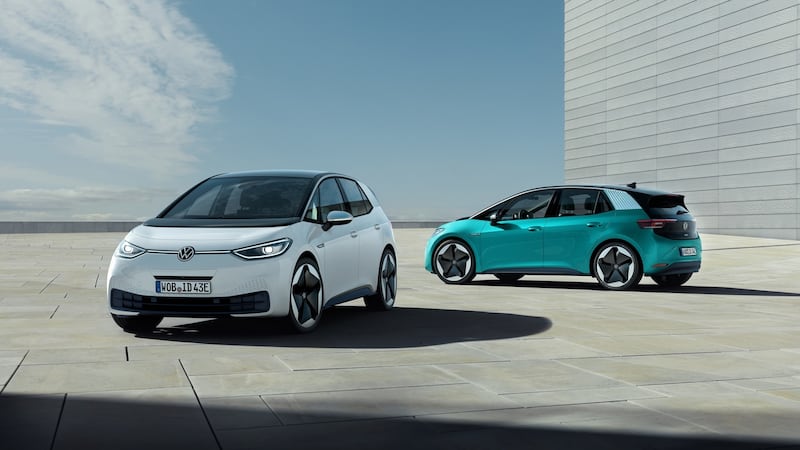Volkswagen is on a major product offensive with two new arrivals in the coming months: one the flagship model for the top of the range, the other arguably the most important VW to be launched since the Golf hit our roads in 1974.
The latest unveiling is of the latest Arteon, the brand’s flagship saloon that sits above the Passat features a new digitial interior, a new engine line-up that includes a plug-in hybrid variant and a sleek new “shooting brake” estate version.
It's the shooting brake that is the talking point: while it offers slightly more headroom and storage space at the back, this is more closely akin to a stretched coupé than a boxy estate. That's a trait in keeping with the Arteon range, for the model has always tried to define itself through sleeker design, having its roots in the original planning for the Passat CC four-door coupe of a decade ago. It's such a sleek look that without the prominent VW badge it bears the sort of lines you expect from the style-conscious brands such as Alfa Romeo, rather than the people's wagon maker. But of course it's not going to be a strong seller in Ireland, where we still can't shake off our prejudice against estates.
Instead we can expect most Arteon customers to turn to the squat saloon. And in fairness they will not lose out in terms of practicality, for there is actually little difference in the load carrying ability of either variant: the boot in the saloon is 563 litres (1,557 litres with rear seats down) while the shooting brake estate offers 565 litres (1,632 litres with seats down). It's just a matter of taste: continental Europe likes the longer sweeping look while Irish buyers still can't get over the fact it's a big hatchback.
Engines
In terms of engines it will feature a 1.5-litre 150bhp petrol, and a 2-litre petrol with 190bhp or 280bhp. A 2-litre diesel with either 150bhp or 200bhp will also be on offer. The big news, however is a plug-in petrol-electric hybrid version, featuring a 1.4-litre petrol engine combined with an electric motor to put out 218bhp and thanks to its 13kWh battery, capable of 54km on full electric mode, according to VW engineers.
Yet for all the interest in this particular plug-in, the real charge at VW will be for the ID.3, its all-important electric hatchback and the car that may take over from the evergreen Golf as the default VW, which arrives in Ireland in the next few months Ireland with a starting price of €33,625.
That's taking the €10,000 VRT rebate and SEAI grant into account, and is the base price for the initial ID.3 1st model – a limited edition version built for those who got their orders in early. Numbers will be severely limited until the factory in Zwickau, Germany – where the ID.3 is built – gets up to full speed. When it does, VW says that it has the capacity to build some 330,000 ID.3s each year.

Basic equipment will include 18-inch alloy wheels (called ‘East Derry’ wheels in VW’s brochure, but we suspect there’s no Derry Girls connection, at least not yet), a large “Discovery” multimedia touchscreen, a leather steering wheel, heated seats, adaptive cruise control with traffic stop-and-go, two-zone climate control, and LED headlights.
There will also be an ID.3 1st Plus, priced from €40,595 after grants, and an every-option-fitted ID.3 1st Max, priced from €47,545 after grants.
All three models will come with a 58kWh battery pack, which will give the ID.3 a range of roughly 420km, although VW admits that could fall to 330km in real-world conditions. A more affordable version with a smaller battery and shorter range will be available in 2021.
‘Show me the stars’
The car will come with a huge number of high-tech options, including LED lights that “look” at you as you approach the car, and clever voice control that will open the panoramic roof blind if you say “show me the stars”. However, VW is still racing to sort the car’s software, which has been the subject of numerous delays. The initial 1st-spec cars will actually ship with incomplete software, so some of the functions for the internet-based App Connect system, and the top-spec Max version’s augmented reality heads-up display will not be ready.
Owners will be given a full software update, which will be available, according to VW, in the first quarter of next year, but although the ID.3 will eventually be able to receive wireless, over-the-air software updates, this first one will require a visit to a dealer. VW has justified the decision to ship the cars with incomplete software, saying: “We have so much fun driving the car, and there are these features that are not yet at the level where we say we want to give it to our customers. They are not yet up to VW standards. And so, we decided to give our pre-bookers the option to still have the car and enjoy what we enjoy every day. And of course that comes with the promise that we will update the car for them.”
Other options will include a heat-pump heating system, which can warm the cabin up more efficiently in winter, but which will be initially only available in colder-climate markets, and, eventually, a vegan option that replaces interior leather trim. There will also be a 77kWh battery option, which will push the range of the ID.3 close to 600km, but it weighs so much that models with that battery will be four-seat models only, as the weight of a fifth passenger would be too much.

















